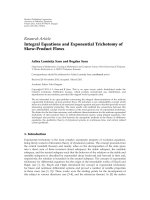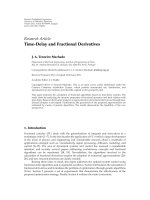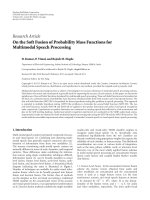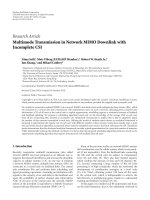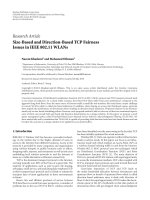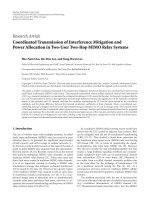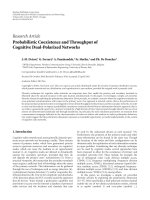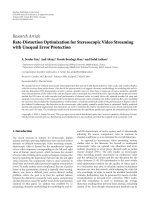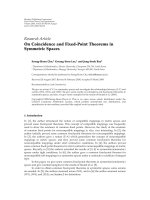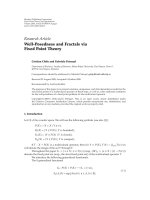Báo cáo hóa học: " Research Article Real-Time Transmission and Storage of Video, Audio, and Health Data in Emergency and Home Care Situations" pdf
Bạn đang xem bản rút gọn của tài liệu. Xem và tải ngay bản đầy đủ của tài liệu tại đây (1.93 MB, 7 trang )
Hindawi Publishing Corporation
EURASIP Journal on Advances in Signal Processing
Volume 2007, Article ID 67818, 7 pages
doi:10.1155/2007/67818
Research Article
Real-Time Transmission and Storage of Video, Audio, and
Health Data in Emergency and Home Care Situations
Ivano Barbieri, Paolo Lambruschini, Marco Raggio, and Riccardo Stagnaro
Department of Biophysical and Electronic Engineering, University of Genova, Via Opera Pia 11 A, 16146 Genova, Italy
Received 13 March 2006; Revised 16 January 2007; Accepted 5 March 2007
Recommended by Ying Wu
The increase in the availability of bandw idth for wireless links, network integration, and the computational power on fixed and
mobile platforms at affordable costs allows nowadays for the handling of audio and video data, their quality making them suitable
for medical application. These information streams can support both continuous monitoring and emergency situations. According
to this scenario, the authors have developed and implemented the mobile communication system which is described in this paper.
The system is based on ITU-T H.323 multimedia terminal recommendation, suitable for real-time data/video/audio and telemed-
ical applications. The audio and video codecs, respectively, H.264 and G723.1, were implemented and optimized in order to obtain
high performance on the system target processors. Offline media streaming storage and retrieval functionalities were supported
by integrating a relational database in the hospital central system. The system is based on low-cost consumer technologies such
as general packet radio service (GPRS) and wireless local area network (WLAN or WiFi) for lowband data/video transmission.
Implementation and testing were carried out for medical emergency and telemedicine application. In this paper, the emergency
case study is described.
Copyright © 2007 Ivano Barbieri et al. This is an open access article distributed under the Creative Commons Attribution License,
which permits unrestricted use, distribution, and reproduction in any medium, provided the or iginal work is properly cited.
1. INTRODUCTION
Wired and wireless communication technologies can strong-
ly help providing health care in several situations. Real-time
transmission, storage, a nd retrieval of vital parameters are
nowadays possible.
Electrocardiogram (ECG), blood pressure, and other pa-
tient’s information can be exchanged between remote op-
erators and specialized medical centers. Health data can be
thus evaluated in real-time or offline after storage. Today,
telemedicine is often applied for ill or elderly people in home
care monitoring. The repetitive (daily or more frequent)
monitoring of health parameters allows for the checking of
long term variation and for prompt intervention. At the same
time, real-time health parameter transmission in emergency
situations can be crucial. In a previous project on multime-
dia functionalities in telemedicine systems, we used custom
electronic cards and professional transmission network (e.g.,
Tetra). This approach is suitable (often required) for a net-
work mainly connecting people working in the medical area.
Nevertheless, in a scenario where large number of citizens
ask for continuous monitoring, prompt intervention, and in-
teraction with medical establishment, further requirements
should be evaluated in order to provide new services at af-
fordable costs. A possible solution would be to use standard
equipment (less custom made as possible), commercial net-
works and to implement widely usable man-machine inter-
faces.
2. MAIN ISSUE AND RELATED WORKS
Telemedicine is used to be divided into three main areas:
decision-making aids, remote sensing, and collaborative ar-
rangements for real-time patients’ management. Telecom-
munication technology allows for the supply of medical ser-
vices to sites that are physically separated from the provider
[1], the handling of emergencies, such as medical telemetry
systems [ 2], and the assistance of elderly or disabled people
in domestic environments. Today, available commercial sys-
tems and research prototypes emphasize how this approach
to health care is rapidly evolving. A good example is the real-
time remote ECG system for the monitoring of arrhythmia
in a patient [3]. The system uses an event recorder and trans-
mits to a personal digital assistant (PDA) with Bluetooth
technology. Moreover, PDA tracks the patient’s location v ia
a connection to a global positioning system (GPS) receiver.
2 EURASIP Journal on Advances in Signal Processing
Video codec
H.263/H.261
Audio codec
G711, G722, G.723,
G.728, G.729
Receive
path
delay
H.225.0
layer
System control
H.245 control
Call control H.225.0
RAS control H.225.0
Local area
network
interface
I/O equipment
applications
and control
interfaces
Figure 1: Scope of H.323 terminal equipment recommendation.
A long-distance link is established via a standard Internet
connection over GSM/GPRS infrastructure. The digital sig-
nal is transmitted to a remote computer and displayed us-
ing web technology and monitored by medical professionals
[3]. Another health care wireless application is the wireless-
application-protocol-(WAP-) based telemedicine system for
patient monitoring. WAP technology devices such as mobile
access terminals for general inquiry and patient-monitoring
services are used. Authorized users can browse patients’ gen-
eral data and monitor blood pressure and electrocardiogram
on WAP terminals in store-and-forward mode [4]. Other ap-
plication targets are emergency situations: documentation,
triaging, presentation of checklists, and medical data (e.g.,
electrocardiograms). These critical data are t ransferred from
the ambulance over the data network to the receiving med-
ical facility [5]. Telemedicine also seems to be the main
component of a new patient-centered health care paradigm
[6] based on self-determined citizens/patients where their
full involvement (as far as possible) is required during all
the stages of the health care value chain, from health in-
formation and prevention all the way through to rehabil-
itation and long-term care. A potential advantage of in-
cluding telemedicine in this environment is to give a stan-
dard and flexible response appropriately tailored both to
the long and short-term health care process. Further more,
telemedicine facilitates the continuous monitoring of health
status through the transmission and storage of updated med-
ical and general status data.
3. SYSTEM ARCHITECTURE AND IMPLEMENTATION
The system design follows the criteria of finding the best
compromise between application requirements and available
hardware and software technologies. Addressed technologies
range from multimedia signal processing to human-machine
interfaces (HMI). The support for health medical diagno-
sis, such as ECG and spirometry, is provided by interfacing
the medical terminal equipment data channel to the real-
time data transmission channel. From the physical connec-
tion point of view, medical devices are interfaced using both
Bluetooth and RS232 serial ports. In order to allow real-
time interaction and coordination among users, caregivers
and medical staff, b oth audio and video transmission and
recording require a challenging compromise between qual-
ity and bandwidth occupation. The selected video compres-
sion algorithm is H.264 [7] compliant; G.723.1 [8]isusedfor
speech coding. The system layer follows ITU-T H.323 speci-
fication [9] (see Figure 1).
Note 1. G711, G722, and G728 are audio codec standards us-
able in the H.323 framework. In the described application,
G.723.1 was the selected audio algorithm.
Note 2. H225 is the multiplexer standard for the H.323 spec-
ification.
Data flow through the GPRS public network which is
connected to a private proprietary local area network (LAN).
The Wireless Bluetooth
technology is utilized for short dis-
tance interdevice connections.
The system is composed of a set of portable units (suit-
cases containing a set of devices) and a Hospital central sys-
tem (see Figure 3) with pc-clients and a data server intercon-
nected with a local area network, which is linked to the ex-
ternal private Internet infrastructure. The portable unit com-
municates with the central system using a GPRS private net-
work where the data from the portable unit are routed to a
virtual private network (VPN) using a dedicated access point
(APN). The portable unit system (see in Figure 4)isdivided
into modules which are connected as shown in Figure 2.PDA
and Tablet-PC units perform data/video/audio compression,
decompression, transmission, and provide HMI to the user.
HMI must b e the simplest possible in order to be used by
health care staff [10] but also by patients who may be actively
involved by their physicians in the health care and emergency
delivery process [6].
Ivano Barbieri et al. 3
PDA
Bluetooth
Smartphone
WiFi
Loop
AP
GPRS
PC-card GPRS
Tablet-PC WiFi
Figure 2: Portable unit modules interconnection.
Operator
Operator
Operator
Data
server
Central
server
Portable
unit
Portable
unit
Access
point
GPRS connection
WiFi connection
Virtual private network
Figure 3: Hospital central system and hosted internal clients.
The portable unit can both transmit and store video, au-
dio, and health parameters to the Hospital central system via
GPRS link. If the GPRS connection is not available (due to
environmental situation), data are stored and can be trans-
mitted offline. In this scenario, the portable unit, with wire-
less access point and WiFi embedded into PDA or Tablet-PC,
allows for health care operators or trained patients (or pa-
tient’s relatives) to send real-time video from the place where
health care processes are needed, to the suitcase that is placed
in the neighborhood (usually in the caregivers medical car).
The PDA acquires the video using the secure digital (SD)
video camera and sends the video stream using the cellular
smartphone as GPRS interface. The PDA and the smarth-
phone are connected through the Bluetooth interface. When
the real-time live streaming is not required, data are recorded
with a higher video quality. In this case, the system uses the
wireless LAN instead of the GPRS public connection.
In the most common situations, the smartphone is con-
nected to the Hospital central system using the GPRS inter-
face.
Figure 3 shows the central system. The system can be
both a hospital or a health care center. A central server re-
ceives real-time video/data. During the live media streaming
any client in the center local area network can connect to the
central server and play real-time audio and video. Moreover,
it is also possible to search the st ream database for a stored
stream.
Tablet-PC WiFi bridge
Smartphone PDA
Figure 4: Portable unit (suitcase).
The video server implements an event-driven database
where each client can query for every stored diagnosis event.
HMI allows multiple real-time video stream play (up to
16 simultaneous v isualizations). The central server has a sep-
arate video database administration interface. Administra-
tors can add and remove health care multimedia streams
(video, audio, or audio-video streams) events or perform
other common database administrative operations. The cen-
tral streaming server is also a web server allowing to query
the video database through a simple web browser. The web
access, protected by a user account service, is used to query
the database from external-LAN users.
A multimedia real-time system design and implemen-
tation requires the best compromise between a set of crit-
ical issues related to each other with tradeoffs[11]. Win-
dows XP Professional was chosen for the client terminals and
Windows 2003 Server for the video-server application. Win-
dows .Net technology and Visual Basic programming lan-
guage were found suitable to design the HMI. For a better
overall system performance a sublayer was implemented in
Visual C++.
HMI func tionalities should be easy to access and very in-
tuitive in order to be used by health care staff and trained
patients (elderly people at home or relatives) in critical situa-
tion. The primary target is simplicity and intuition of use. Vi-
sual Basic .Net offers facilities for the engineering of suitable
interface, w ith useful component like info tool tips, and a
very large set of available fonts for buttons and labels. Thanks
to .NET flexibility, the user interface can b e easily modi-
fied without affecting the underline system functionalities.
This feature is used in order to adapt the access of devices
to different patient typologies. The HMI main requirement
is wide usability. Common users are often not familiar with
PC or electronic devices. For this reason, feedback from end
users was crucial. It was also important to implement an in-
terface which could be suitable for both normal and crit-
ical/emergency situations. Figures 5 and 6 show developed
client HMI.
4 EURASIP Journal on Advances in Signal Processing
Video live windows
(up to 16)
Play offline video
window
Figure 5: HMI for client in the hospital.
Figure 6: HMI of the mobile client.
The database was implemented with relational structured
query Language (SQL) database. The central server can man-
age in real time up to sixteen data stream from portable
units. This means it can contemporarily store sixteen video
streams and at the same time respond to live streaming or
database query client requests. A critical issue for the system
was the video and audio database management. Several so-
lutions were explored in order to find an efficient storage
technique. A reliable solution was found by storing audio
and video streams as separate sequences of files and not em-
bedding them in the database. Users can retrieve multimedia
streams with a transparent secure file transfer protocol (Ftp)
download. Secure ftp is suitable for security and privacy of
data content. This technique avoids database overload due to
video/audio data relative high bit-rate. Database can there-
fore store long event sequences, even during tasks such as
Figure 7: Simple web browser interface to access the multimedia
database.
data reordering or data defragmentation operations. Refer-
ence data are stored in the database as small records. Figure 7
shows the web browser interface.
From the data telecommunication point of view, one of
the development challenges was to reach good video/audio
quality with the limited bandwidth provided by GPRS con-
nection [12]. A long time was necessar y to find the best
compromise for packet length in order to achieve the re-
quired quality/bandwidth ratio. The selected and imple-
mented codecs were ITU-T H.264 video encoder and ITU-
T G723.1 5.3 bps fixed bitrate sp eech codec. The chosen
fixed rate maintains good video quality even during GPRS
band lowering for bad signal coverage, with autoframe skip-
ping during video grabbing. The G.723.1 standard algorithm
also supports 6.3 bps, but the audio quality improvement to-
gether versus higher computational load did not match our
application constraints. The chosen video codec performs a
good video quality even when frame dropping is applied. In
this situation (which is common due to GPRS band lower-
ing), the best reachable compromise was found.
The H.264 video coding standard allows for the im-
proving of the compression efficiency while maintaining a
good video quality especially w hen compared with previ-
ous standards. The analysis reported in [13, 14] shows that
the H.264 Baseline Profile achieves an average bitrate savings
for video conferencing applications of about 40% compared
with H.263 [15] baseline encoder. Even when compared with
the H.263 apposite profile for video conferencing (conver-
sational high compression), H.264 still saves about 28% of
the bit rate. The MPEG4 [16] performance lay between the
two H.263 profiles’ values. Moreover, the properties of the
new standard allow for the achievement of high-quality en-
coder effectiveness at both low and high bitrates. The abil-
ity to efficientlyworkatawiderangeofbitratesisacrucial
feature for the here-described system because of the variety
of existing telemedicine applications and their future devel-
opment towards the use of high-bandwidth networks. These
Ivano Barbieri et al. 5
characteristics, together with the network abstraction layer
designed for transporting coded video data over wireless net-
works [17], made H.264 suitable for the designed telemedical
system.
On the other hand, the computation complexity of the
H.264 video coder has largely increased: as reported in [18],
it has grown of more than one order of magnitude when
compared with H.263 [15]andMPEG4[16]. In order to
reduce the H.264 video-encoder computational weight, a
number of algorithm and software optimization were im-
plemented. A fast motion estimation module [19] together
with an adaptive interpolation module was used. Code anal-
ysis and application profiling showed these modules are the
most demanding for the video codec, representing the two
main performance bottlenecks. Implemented optimizations
focused on the capability to adapt codec parameters to in-
put streams. A motion detection (MD) block was integrated
into the video encoder implementation in order to monitor
the stream complexity and to accordingly drive the modules
behavior. Specifically, MD modifies the value of the search
window size parameter in the ME, whereas it changes the
fractional order in the interpolation module. The optimiza-
tion is based on the idea that exhaustive interpolation and
motion search are useful only in video sequences contain-
ing large motions and not in low complex sequences. The
obtained gain in complexity reduction is particularly favor-
able in slow-motion situations because of the restricted num-
ber of motion vectors we usually have in these situations.
Tab les 1 and 2 resume some tests where we encoded stan-
dard sequences at 30 fps [19]. The CAVLC entropy coder and
Hadamard were used for all tests, with quantization values
of 28 (tests using different quantization values can be found
in [19]). The H.264 activated block configurations are 8
× 8
and 16
× 16. Performance is measured in terms of time em-
ployed to compress the test sequences and the compression
rate in terms of compressed sequence size. These values are
compared to the reference software and the difference in per-
centage is shown in Tables 1 and 2. The quality is evaluated
using the SNR Y, measured by the jm6.0a [20]testmodel
(differences are shown in decibel).
From these results we observe that the proposed ap-
proach simplifies the encoder complexity achieving from
50% to 60% encoding time reduction in typical video-
surveillance and video-telephony sequences. Anyway, also
the worst-case foreman shows a good computational time
reduction (about 25%). It should be noted that the H.264
coding efficiency has only slightly decreased [19]. Thanks to
the described modification to motion estimation we were
able to exploit the remarkable bitrate versus quality baseline-
H.264 performance when compared to H.263 and MPEG4
[15, 16] with a low computational load increment. The high
video quality allowed by H.264 match our application re-
quirements where high quality video at a limited bandwidth
is required.
In addition, a set of H.264 modules was implemented
using optimized assembly (WMMX for the Handheld and
MMX for Tablet-PC) in order to improve software perfor-
mance and to decrease power consumption [21].
The audio coding implementation together with the au-
dio/video synchronization introduces a lot of new issue such
as delay, continuous play, and lip synchronization.
IP packet over the GPRS network shows variable de-
lays and will arrive at a nonunifor m rate. This effect is in-
creased by the GPRS band lowering. Decoders must process
data packets into constant streams, therefore buffers must
be implemented at the receiving site [22]. We implemented
adynamicjitterbuffer starting with a small size buffer in-
creasing progressively if needed. Moreover, we decided to use
an audio-priority multiplex scheme allowing to improve the
perceived quality to receiver. Experimental test shows from
50 ms up to 200 ms delay for packet over the public GPRS
network. We obtained further performance improvement
using silence suppression to resynchronize the jitter buffer
(user does not perceive audio discontinuity during silence).
The average jitter buffer compensate a delay of about 100 ms.
Information (audio, video data, and control) is sent
though GPRS in several ways. Media packets (audio and
video) using UDP (nonblocked) socket. Other data (con-
trols and data such as biomedical data) are sent using TCP
(blocked) socket. In order to keep audio and video synchro-
nized the multiplex algorithm (H.225) uses time stamps.
As descr ibed above, we decided to store audio and video
stream files separately for database reliability. In order to
obtain synchronization, timestamps were also inserted into
stored audio and video streams. If audio is present, video
stream is resynchronized using timestamps for minimizing
delay. For real-time transmissions, the main problem is to
play a continuous audio stream, without holes or interrup-
tions. This is accomplished with a shor t time prebuffering
for the audio stream, which is processed at a higher priority
then the video stream (audio priority).
4. TESTING AND RESULTS
The described system was implemented to be used in two
main test applications: telemedicine in emergency handling
and remote health care for patients. In this paper, the emer-
gency case study is described. Field tests of the system
were performed by regional emergency organization “(118).”
Emergency staff use is definitely a meaningful test case to ver-
ify system functionalities, efficiency, and usability. From the
GPRS network point of view, two different kinds of terminals
were used for the test. The smartphone having 4 + 1 times-
lots with a CS2 coding scheme resulting in 53.6 kbps down-
stream and 13.4 upstream and the pcmcia card on the Tablet-
PC using a 4 + 2 timeslots with the same downstream but
an upstream of 26.8 kbps. Real-time video used QCIF frame
size. The system was used for about one year, s o far. Multi-
media streams support was mainly employed in emergency
scene description in order to better transfer urgent situation
needs to the Hospital central system and to process offline
(using the stored video) the protocol which is followed in
emergency handling. Recorded emergency events were also
used to provide the audio-video documentation of interven-
tions. In those situations, the use of real-time multimedia
streaming influences the medical protocol from a logistical
6 EURASIP Journal on Advances in Signal Processing
Table 1: QCIF (v ideo image format 176 × 144), quantization 28.
QCIF 28 Time % Total bit % SNR Y (db)
Hall −62.29 0.00 0.00
Silent
−59.58 +0.03 −0.01
News
−60.02 0.00 0.00
Foreman
−41.57 +0.06 −0.02
Akiyo
−62.95 0.00 0.00
rather than clinical point of view. Feedback from the end
user (medical staff ) was collected after the test of the system.
In the following lines some key points are listed. The audio
stream was generally useful for emergency event recording,
adding a lot of information about medical staff behavior and
situation approach. About the real-time-video transmission,
(i) the video qualit y is acceptable even in GPRS band low-
ering (worst case);
(ii) the system supports decision-taking processes thanks
to audio and video real-time data, thus facilitating the
work of professionals located in remote hospital cen-
tral system;
(iii) the real-time audio and video connection al lows for a
better understanding of the actual situations and feel-
ings of patients by the remote medical staff.
While accessing offline to the audio-video-data storage,
(i) database query allows users to bypass some paper doc-
umentation, (the database storage include user identi-
fier, ambulance id, timestamp);
(ii) hospital staff can review each moment of an emer-
gency event to evaluate how it was handled;
(iii) the audio and video documentation allows users to
give advice in legal disputations such as ambulance ac-
cidents or mistakes in patient treatment;
(iv) educational purposes: the possibility to use multime-
dia streams for new staff training;
(v) recorded intervention allows offline analysis to im-
prove emergency protocol effectiveness.
For all these points, emergency staff considers the intro-
duction of the system as a positive improvement in the han-
dling of emergencies.
5. CONCLUSIONS AND DEVELOPMENTS
In this paper, a low cost system for supporting remote medi-
cal situation based on wireless connection and database stor-
age has been described. The system makes use of real-time
audio/video and medical parameters transmission and stor-
age, in order to provide reliable and timely data to clini-
cians. It can be transported to handle situations where there
is no radio connection coverage (GPRS). The system has
been tested in actual emergency situation receiving positive
feedback from the emergency staff. Further tests will focus
on remote health care handling for elderly people. The use
of wider bandwidth (e.g., UMTS) will improve video/audio
quality and the effectiveness of data transmission. Future de-
Table 2: CIF (video image format 352 × 288), quantization 28.
CIF 28 Time % Total bit % SNR Y (db)
Hall −67.02 +0.03 −0.01
Silent
−60.16 +0.03 −0.01
News
−59.52 +0.05 −0.02
Foreman
−26.18 +0.05 −0.02
Akiyo
−65.40 0.00 0.00
sign will address weight and size reduction in order to im-
prove the system portability and support for a larger number
of medical peripherals. Future developments will address in-
tegration of informative streams for emergency and hospital-
ity in order for patients’ history to be made quickly available.
The design criteria to implement standard protocols and
algorithms following the H.323 framework outcome allow
for high flexibility in system integration with last generation
medical devices. Several telemedical systems are still designed
according to ad hoc solutions. Usually this means that only
a limited set of devices can be interfaced. Design criteria fol-
lowing standard recommendations will benefit not only in-
tegration issues: such standards will be included in next gen-
eration home entertainment s et-top box for multimedia de-
coding. Thanks to the availability of higher bandwidth net-
working and WiFi capability for the domestic environment,
the next gener ation set-top boxes will be the commonly avail-
able gateway interfacing domestic environment devices. In
the future wireless health care sensors could therefore be in-
terfaced in domestic environment to implement real-time
health parameter acquisition in the monitoring, for example,
of ill or elderly people.
REFERENCES
[1] “Telemedicine in emergency medicine,” Information Paper,
American College of Emergency Physicians, Dallas, Tex, USA,
June 1998.
[2] E. Kyriacou, S. Pavlopoulos, D. Koutsouris, A. S. Andreou,
C. Pattichis, and C. Schizas, “Multipurpose health care
telemedicine system,” in Proceedings of the 23rd Annual Inter-
national Conference of the IEEE Engineering in Medicine and
Biology Society (EMBS ’01), vol. 4, pp. 3544–3547, Istanbul,
Turkey, October 2001.
[3] K. J. Liszka, M. A. Mackin, M. J. Lichter, D. W. York, D. Pil-
lai, and D. S. Rosenbaum, “Keeping a beat on the heart,” IEEE
Pervasive Computing, vol. 3, no. 4, pp. 42–49, 2004.
[4] K . Hung and Y T. Zhang, “Implementation of a WAP-based
telemedicine system for patient monitoring,” IEEE Transac-
tions on Information Technology in Biomedicine, vol. 7, no. 2,
pp. 101–107, 2003.
[5] R. Karlsten and B. A. Sj
¨
oqvist, “Telemedicine and decision
support in emergency ambulances in Uppsala,” Journal of
Telemedicine and Telecare, vol. 6, no. 1, pp. 1–7, 2000.
[6] M. Pieper and K. Stroetmann, “Patients and EHRs tele home
monitoring reference scenarios,” in Universal Access Code of
Practice in Health Telematics, C. Stephanidis, Ed., vol. 3041 of
LNCS, pp. 77–87, Springer, New York, NY, USA, 2005.
[7] ISO/IEC 14496-10, ITU-T Rec.H.264, Joint Video Specifica-
tion, October 2002.
Ivano Barbieri et al. 7
[8] ITU Rec. G.723.1: dual rate speech coder for multimedia com-
munications transmitting at 5.3 and 6.3 kbit/s. 03/96.
[9] ITU-T Recommendation H.323-v5, “Packet based multimedia
communications systems,” 7/03.
[10]M.Ackerman,R.Craft,F.Ferrante,etal.,“Chapter6:
telemedicine technology,” Telemedicine Journal and e-Health,
vol. 8, no. 1, pp. 71–78, 2002.
[11] R. B. Lee and M. D. Smith, “Media processing: a new design
target,” IEEE Micro, vol. 401, no. 1-2, pp. 6–9, 1996.
[12] S. N. Fabri, S. Worrall, A. Sadka, and A. Kondoz, “Real-time
video communications over GPRS,” in Proceedings of the 1st
International Conference on 3G Mobile Communication Tech-
nologie, pp. 426–430, London, UK, March 2000.
[13] J. Ostermann, J. Bormans, P. List, et al., “Video coding with
H.264/AVC: tools, performance, and complexity,” IEEE Cir-
cuits and Systems Magazine, vol. 4, no. 1, pp. 7–28, 2004.
[14] T. Wiegand, G. J. Sullivan, G. Bjøntegaard, and A. Luthra,
“Overv iew of the H.264/AVC video coding standard,” IEEE
Transactions on Circuits and Systems for Video Technology,
vol. 13, no. 7, pp. 560–576, 2003.
[15] ITU-T Recommendation H.263, “Video coding for low bitrate
communication,” February 1998.
[16] I. Richardson, H.264 and MPEG-4 video compression,JohnWi-
ley & Sons, New York, NY, USA, 2003.
[17] T. Stockhammer, M. M. Hannuksela, and T. Wiegand,
“H.264/AVC in wireless environments,” IEEE Transactions on
Circuits and Systems for Video Technology,vol.13,no.7,pp.
657–673, 2003.
[18] S. Saponara, C. Blanch, K. Denolf, and J. Bor mans, “The JVT
advanced video coding standard: complexity and performance
analysis on a tool-by-tool basis,” in Packet Video Workshop (PV
’03), Nantes, France, April 2003.
[19] G. Bailo, M. Bariani, I. Barbieri, and M. Raggio, “Search win-
dow size decision for motion estimation algorithm in H.264
video coder,” in Proceedings of International Conference on Im-
age Processing (ICIP ’04), vol. 3, pp. 1453–1456, Singapore, Oc-
tober 2004.
[20] JVT Reference Software version jm 6.0a, />suehring/tml/download/.
[21] N. C. Paver, “Intel w ireless MMX technology,” in Intel Devel-
opers Forum (IDF ’02), San Jose, Calif, USA, September 2002.
[22] A. J. Hes and R. van Teeffelen, “Implementing voice over IP,”
The European Journal for the Informatics Professional, vol. 2,
no. 3, pp. 4 pages, 2001.
Ivano Barbieri was born in Genova, Italy, in
1969. He obtained his M.S. degree in elec-
tronic engineering at Genova University—
thesis on “Research on image quality eval-
uation alternative methods to MSE (mean
square error) in image coding systems for
the subjective redundancy reduction,” and
Ph.D. degree—thesis on “Efficient method-
ologies for multimedia communication ter-
minal design and testing.” Since 1995, he
has been employed at the Department of Biophysical and Elec-
tronic Engineering (DIBE) of Genova University. Research ar-
eas are innovative approach on image quality evaluation, ar-
chitectural research on systems for real-time efficient imple-
mentation of video coding algorithms exploring both embed-
ded and single-chip solutions, real-time multimedia system
(platforms, multiplexing, and control issues), DSP architecture
and development environment, architecture modeling for media
processing and embedded system for mobile (low power) applica-
tion.
Paolo Lambruschini wasborninGenova,
Italy, 1974. He obtained the Laurea degree
from University of Genova in 2005 writing
a thesis on “Research on digital signal pro-
cessor for TV signal elaboration.” Presently,
he is a Ph.D. student at the Department of
Biophysical and Electronic Eng ineering at
the University of Genova, Italy. Current re-
search areas are digital signal processing for
innovative power supply matrix converters,
image and video coding and processing.
Marco Raggio wasborninChiavari(Gen-
ova), Italy, in 1964. He obtained his M.S.
degree in electronic engineering at Genova
University—thesis on “De velopment and
real-time test of video compression algo-
rithms,” and Ph.D. degree—thesis on “Im-
plementation and simulation of real-time
multimedia embedded system for video
telephony application and advanced DSP
architecture.” Since 1995, he has been em-
ployed as a Research Project Manager/Officer at the Department of
Biophysical and Electronic Engineering (DIBE) of Genova Univer-
sity. In electronic system field, his interests involve hardware de-
sign and simulation, interactive real-time multimedia architecture
design, that is, for mobile terminal and surveillance systems. His
activities involve also field trials setup, audit, and dissemination.
In networking field, he has expertise in LAN design, configuration,
maintenance, security. He teaches on university seminars on video
coding, standards for multimedia and streaming, DSP, industrial
field bus, and embedded systems.
Riccardo Stagnaro was born in Genova,
Italy, 1974. He obtained the Laurea de-
gree from University of Genova in 2001
writing a thesis on “Study, simulation, and
implementation, oriented to Hw/Sw code-
sign of a motion estimation coprocessor
for ITU-T H.264 video compression algo-
rithm.” Presently, he is a Ph.D. student at
the Department of Biophysical and Elec-
tronic Engineering at the University of Gen-
ova, Italy. Current research areas are HW/SW codesign of pro-
grammable electronic systems for real-time acquisition and pro-
cessing of images and video sequences.
